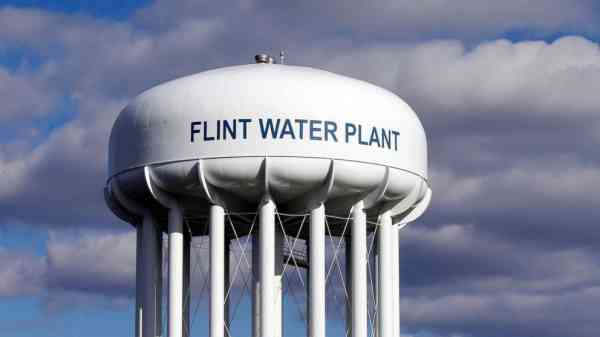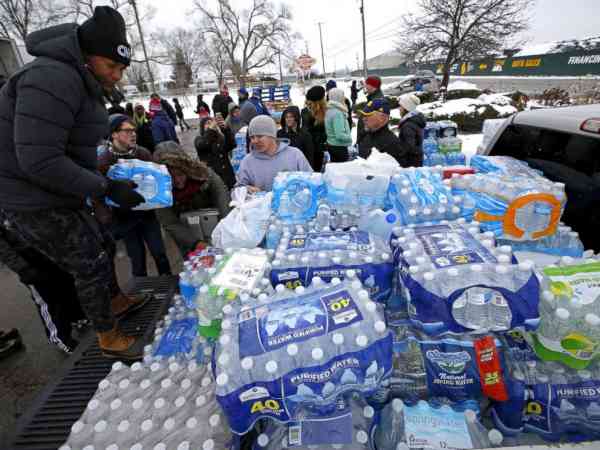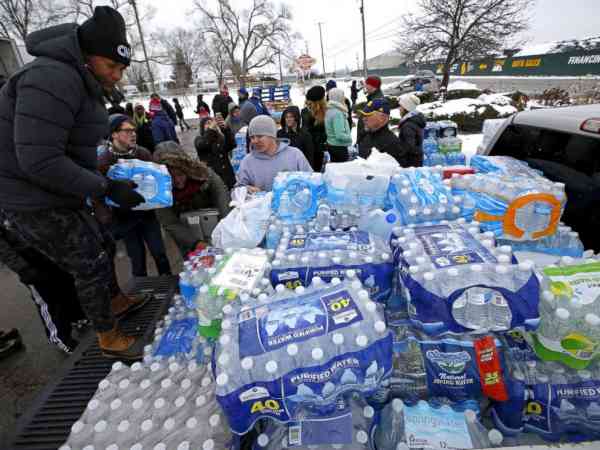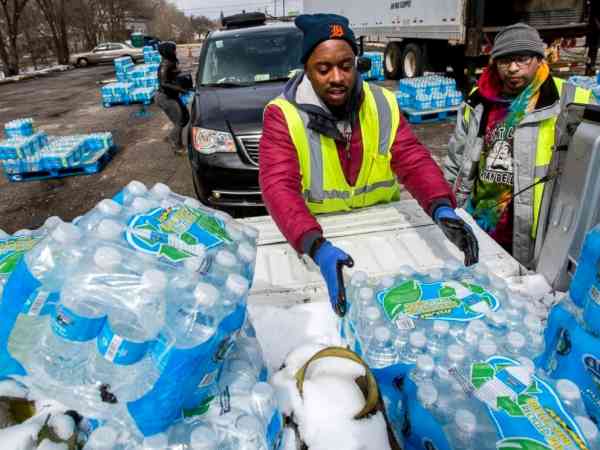
The report on the government response to the crisis in Flint, released Thursday, said there were “implementation and oversight lapses” from the city, Michigan environmental agency, and EPA, and calls for the federal government to take a bigger role in ensuring that state drinking water systems are safe.
The EPA inspector general found that the EPA did not effectively carry out its oversight role under the Safe Drinking Water Act, that the city did not adhere to rules intended to prevent lead exposure, and that the Michigan state environmental agency’s delayed response exposed Flint residents to more lead.
“While oversight authority is vital, its absence can contribute to a catastrophic situation,” EPA Inspector General Arthur A. Elkins said in a statement. “This report urges the EPA to strengthen its oversight of state
drinking water programs now so that the agency can act quickly in times of emergency.”

Jim Young/Reuters, FILEVolunteers distribute bottled water to help combat the effects of the crisis when the city’s drinking water became contaminated with dangerously high levels of lead in Flint, Michigan, March 5, 2016.
The report also found that the EPA regional office knew there were signs Michigan had problems in its drinking water program but the office didn’t intervene to make sure the state was enforcing drinking water standards.
“The EPA office didn’t take action to step in and fulfill those requirements that the state had divested from. Again, our review focused specifically on lead in Flint. So we can’t really speak much more broadly about the Michigan drinking water program but our conclusion is that there were signs that there were issues in the Michigan drinking water program and those unfortunately manifested themselves in Flint with the lead crisis,” Katie Butler, Director of Water Evaluations for the EPA inspector general, told ABC News.
Butler said the inspector general’s office did hundreds of interviews as part of the audit since they began the audit in January 2016. The office previously found that situations like Flint should generate a “greater sense of urgency,” partly because the agency let state officials attempt to deal with the crisis for too long before the federal government intervened.

PlayEPA inspector general’s office releases findings on Flint water crisis
An EPA spokesman said they have reviewed a draft of the inspector general’s report and that the agency has already moved to take action on several of its recommendations.
“The Office of Water, Office of Enforcement and Compliance Assurance, and Region 5 have already taken steps to implement several of those recommendations and will continue to expeditiously adopt the rest. EPA has provided the Office of the Inspector General with a detailed outline of its planned corrective actions and projected completion dates. The Agency is actively engaging with states to improve communications and compliance with the federal Safe Drinking Water Act to safeguard human health,” the spokesman said in a statement.
(MORE: What Life Is Like in Flint, Michigan, 3 Years Into the Water Crisis)
(MORE: Watchdog: EPA Delayed Flint Emergency Order by 7 Months)
The EPA is working to revise the Lead and Copper Rule that sets requirements for the amount of lead that is acceptable in drinking water, provide training for EPA staff, implement a system to evaluate state drinking water systems for potential risks in response to the report’s recommendations, and more clearly define when the EPA should intervene in state issues in response to the report’s recommendations.
The inspector general’s conclusion that there should be more federal oversight of the drinking water rule seems to conflict with the administration’s view that the agency should work more collaboratively with states on regulations. One of the inspector general’s recommendations in the report was for the EPA to update a rule that sets limits for the amount of lead allowed in drinking water and create a system to verify that states are complying with the rule every year.
The report says the EPA agreed to update the Lead and Copper Rule that regulates lead in drinking water by February 2019 but that the agency wanted to create a pilot program on how to make sure states are enforcing that rule, saying it was “vital” they collaborate with state governments to create that program.

Jim Young/Reuters, FILEVolunteers distribute bottled water to help combat the effects of the crisis when the city’s drinking water became contaminated with dangerously high levels of lead in Flint, Michigan, March 5, 2016.
The inspector general said a pilot program is not enough for the recommendation that the EPA establish “annual controls” on states and that the recommendation is not yet resolved.
Butler said part of that recommendation is to make sure that states know the EPA can intervene if there is a public health threat and the state isn’t taking action.
“EPA is concerned with making sure that they have good partnerships with states. EPA certainly needs good partnerships with states to make sure that many environmental regulations are implemented and enforced appropriately. This is a case where the relationship that EPA had with the state of Michigan focused more on the partnership aspect than it did on the oversight aspect,” Butler said.
Rep. Dan Kildee, D-Mich., represents Flint and said that the report released Thursday was a form of victory for families in Flint.
Kildee said he has been pushing for legislation that would update lead regulations since he learned of the crisis in Flint and would keep pushing for the administration to update the Lead and Copper Rule.
The Rule has not been updated in more than 25 years and the Trump Administration continues to delay action,” he said in a statement. “I will continue fighting to make sure that Flint families have the resources they need to recover from this man-made tragedy and work so that a similar crisis does not happen elsewhere.”
Another problem the report identified was that the EPA regional office did not convey the urgency of the situation when communicating with EPA headquarters. Butler said the office was not aware of the extent of lead contamination at the time they were asking EPA headquarters for guidance so there was “less of a fire” underneath the discussions. She said the EPA has since made changes to make sure that any issues that could impact human health are escalated more quickly.

APWater distribution employee Albrey Kirkland places water cases into the back of a pickup at a water distribution center on North Franklin Avenue, April 5, 2018 in Flint, Mich.
City officials in Flint, Michigan changed the city’s water supply in 2014 but the water wasn’t treated properly, exposing city residents to elevated lead levels that are considered harmful to young children. The city and state declared a state of emergency in the city the next year after water still tested positive for lead even after the city switched to a different water source.
Acting EPA Administrator Andrew Wheeler said in his first remarks to EPA employees that Flint is an example of how the agency needs to improve the way it communicates with communities impacted by environmental events.
Sourse: abcnews.go.com
0.00 (0%) 0 votes


































